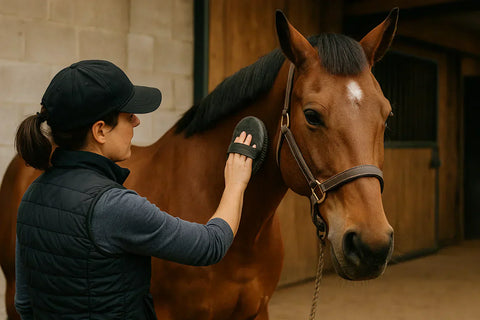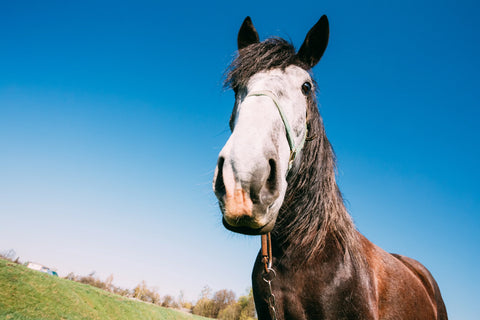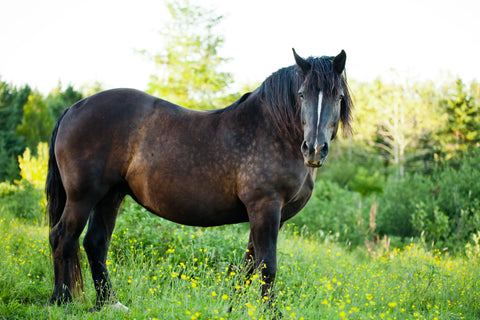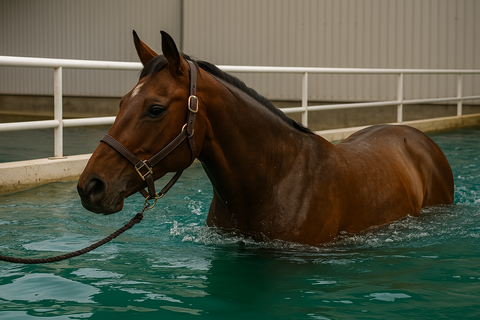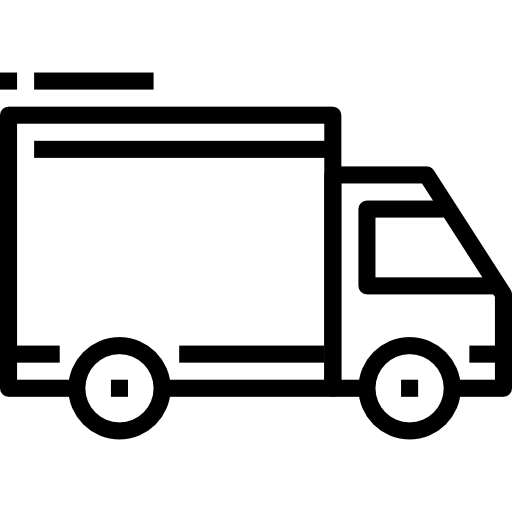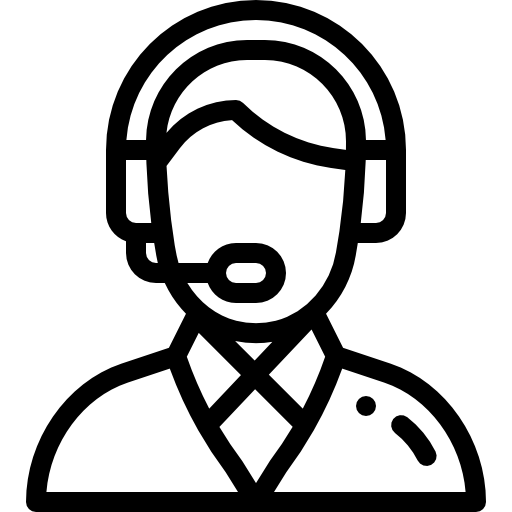
Percheron Horse: origin, temperament and usefulness of this iconic breed
of reading - words
The Percheron is that gentle giant we sometimes see in the fields pulling a plough, or in the streets leading a carriage. Massive, powerful, calm – it embodies quiet strength. But behind those muscles lies a fascinating history and a much broader role than that of a simple draught horse. This guide explores what makes the Percheron unique, from past to present.
Origin and history of the Percheron
From war horses to working horses
The Percheron was born in the Perche region of France, between Orne and Eure-et-Loir. As early as the Middle Ages, it was used as a war horse, strong enough to carry an armoured knight into battle – more than 600 kg of horse and steel at full gallop.
When artillery replaced lances, the Percheron found new work. It became a post horse, a farm horse, a logging horse. It did everything. Thanks to its endurance and docile nature, it became essential in rural life. Our grandparents saw it pulling hay carts and logs through the woods.
It’s a rustic breed – low-maintenance, tough, and hardworking.
A French breed with global reach
The Percheron didn’t just stay in France – it conquered the world. From the 19th century, it was exported to the USA, Canada, and Japan.
In the United States, it became the most popular draught horse. Thousands were shipped across the Atlantic. Percherons pulled New York trams, pioneers’ wagons, and farming tools across the plains. You can still find them in vintage prints and old Western photos.
Today, American Percherons are often heavier and stockier, sometimes crossbred to suit local needs. But they still carry the essence of the French bloodline.
The role of the studbook and today’s breeders
The Percheron studbook was founded in 1883. Its mission: preserve the purity of the breed. Only horses registered in this official book can be called “Percheron.”
Today, the SHPF (Société Hippique Percheronne de France) plays a major role. It runs shows, certifies serious breeders, and promotes Percherons born in France.
At agricultural fairs, we’ve met breeders who all share the same feeling: pride. Raising a Percheron means protecting living heritage. Some even see it as a personal calling.
And the public responds. Country fairs, draught horse demos, and carriage parades still draw crowds. Because the Percheron is more than a horse – it’s history in motion.
Morphology and physical characteristics
Average height and weight of a Percheron
The Percheron makes an impression from the first glance. It’s a massive, broad, solid horse. On average, it stands between 1.60 m and 1.80 m at the withers. Males can even exceed this. In terms of weight, they range from 700 to 1,200 kg, depending on the bloodline.
There are two main types:
-
The light Percheron, more refined, once used for postal service or fast harness work
-
The heavy Percheron, more muscular, built for farming and forestry work
Even the foals are sturdy. They grow quickly, with strong bones and powerful build from a young age.
Typical coat colours and visual features
What stands out first is the coat. The most common colours are light grey, dapple grey, or black. Grey is dominant in France. Foals are often born black, then gradually lighten with age.
Other key features include:
-
A square, expressive head
-
Large, alert eyes
-
A straight profile
-
No heavy feathering on the legs, unlike other draught breeds
It has a broad, arched neck, sloping shoulders, and robust limbs. Every detail gives off an impression of controlled strength.
Power, movement and presence: how to recognise one
A Percheron doesn’t go unnoticed. It moves with a fluid, proud gait, even when pulling weight. Its stride is broad, steady, almost noble.
In a parade, in harness or working the land, you can spot it instantly:
-
Compact, muscular body
-
Powerful hindquarters
-
Straight head, alert ears, calm eyes
But above all, it radiates a rare mix of strength and gentleness. That’s what strikes you when you’re near one. You feel small… but never unsafe.

Temperament and behaviour
A calm, intelligent horse with a strong bond to humans
The Percheron is a gentle giant. It’s nothing like a nervous or unpredictable horse. It’s often described as steady, thoughtful and patient. It watches, learns fast and stays calm in most situations.
Spend time with one, and you feel a genuine connection. It’s attentive, curious and seeks interaction. It enjoys being groomed and involved. Many breeders describe it as a horse that “wants to please”, and it shows in how it works with people.
It responds well to a calm voice, simple gestures, and consistent handling. No need to be forceful — just be clear. It follows.
Suitable for beginners and children?
Absolutely. Despite its size, the Percheron is more impressive than intimidating. It’s stable, doesn’t make sudden movements, and forgives mistakes. It stays composed even when something unexpected happens.
That makes it ideal for beginner riders, with proper supervision. With children, it’s the same — in a petting zoo or for carriage rides, it brings comfort and trust. Of course, no one hands a 900 kg horse to a child unsupervised. But with an adult, it’s a dependable partner.
It’s not a tense sport horse. It moves at its own rhythm, listens well, and stays cool.
Trainability and work ethic
The Percheron loves to work. It understands what’s expected quickly. A clear, consistent approach is all it takes. It can be trained to accept a collar, long reins, voice cues, bells, tools, harnesses…
It’s not easily spooked. It gets used to sounds, gestures and routines. It allows handling, saddling and harnessing without resistance. It won’t bolt or rear at the first sign of stress.
And most importantly: it remembers what it learns. Once trained, it becomes a reliable teammate, capable of working for hours without fuss. Whether pulling, riding or in harness, it gives its best — calmly and willingly.
What is a Percheron used for today?
Versatile: carriage, logging, leisure
The Percheron is the Swiss army knife of draught horses. It fits into nearly every use. You’ll still see it in traditional carriage work — pulling wedding carts or farm wagons.
In forests, it’s one of the best horses for logging. It goes where machines can’t and doesn’t damage the ground. Its strength lets it pull heavy loads gently, silently and with low environmental impact.
And for leisure? Some riders use it for trail riding or carriage outings. It doesn’t have the stride of a thoroughbred, but it moves with consistency, safety and heart.
It also appears in pulling contests or public demos. It’s comfortable anywhere it's asked to show strength — quietly.
An asset for sustainable farming
The Percheron is making a comeback in the fields, and it’s no coincidence. It attracts young farmers who want to work differently. It replaces or complements tractors, especially on small plots, vineyards, market gardens or organic farms.
Why?
-
No fuel
-
No soil compaction
-
No engine noise
-
Less stress on surrounding animals
It’s a living partner, not a machine. It requires care, but it gives back presence, rhythm and clean energy. Some breeders even call it a true farm teammate.
Integration into educational farms and tourism
Percherons are showing up more and more in educational farms, animal parks, and rural activity centres. Their gentle nature and impressive size attract visitors without scaring them off.
They’re often involved in:
-
Carriage rides
-
Ploughing demonstrations
-
Animal traction activities
-
Grooming sessions for children
They quickly become the star of the farm — the one people come to pet, photograph, and admire.
In some cities, they’re even back at work collecting rubbish, maintaining green spaces, or starring in local parades. The Percheron is returning to everyday life, bringing connection, calm… and a touch of nostalgia.
Health, care and feeding
Lifespan and hardiness
The Percheron typically lives 20 to 25 years, sometimes more with good care. It’s a very hardy breed. It rarely falls ill, recovers well after effort, and handles cold weather easily. Its strong build and steady temperament make it a reliable long-term companion.
Many Percherons continue working up to 18 or even 20 years old, with no major drop in form. It keeps going, keeps showing up, keeps working.
Feeding adapted to its size
A Percheron eats a lot — but balance is key. It needs:
-
High-quality hay, lots of it
-
Clean water at all times
-
Extra feed if doing regular work
-
Vitamins and minerals if the diet lacks variety
Typical daily needs:
-
25 to 30 kg of hay
-
Concentrates if working
-
Supplements for balance
Avoid too much grain: too much energy = weight gain. The rule: balance and routine.
Hoof care and routine vet needs
The Percheron’s feet are wide, tough… and heavy. Regular hoof trimming every 6 to 8 weeks is essential to avoid lameness.
Shoes or no shoes? That depends:
-
No shoes if living in pasture with little work
-
Partial or full shoeing if logging or walking on rough ground
Standard care includes deworming, flu and tetanus vaccines, and regular checks for parasites and teeth issues, just like any horse.
Breed-specific precautions (weight, heat, etc.)
The Percheron tends to gain weight easily. Avoid over-rich pasture, keep an eye on feeding, and make sure it gets regular exercise.
It handles cold well, but struggles with extreme heat. Because of its size, it can overheat quickly. In summer, it needs:
-
Shade
-
Plenty of water
-
No effort during peak heat
Its pace is naturally slow, so avoid intense work without warming up. It’s better to build up gradually than to push it too hard too fast.
Percheron vs other draught horses
Boulonnais, Ardennais, Breton: what are the differences?
Each draught horse breed has its own traits. Here's a clear comparison:
| Breed | Average height | Common coat | Temperament | Key features |
|---|---|---|---|---|
| Percheron | 1.60 – 1.80 m | Grey or black | Calm, willing | International popularity |
| Boulonnais | 1.60 – 1.75 m | Light grey | Elegant, energetic | Slimmer, more refined build |
| Ardennais | 1.55 – 1.65 m | Roan, bay, chestnut | Quiet, hardy | Short, extremely strong |
| Breton | 1.55 – 1.70 m | Chestnut, roan | Honest, docile | Versatile, common in riding centres |
The Percheron remains the tallest and most imposing, yet with a certain elegance for a draught breed. It’s also known for its global reputation, unlike some of the more localised breeds.
Why choose a Percheron?
People choose the Percheron for:
-
Its versatility: pulling, driving, riding
-
Its controlled power
-
Its robustness
-
Its gentle temperament
-
Its ease of training
It’s a reliable working horse, but also a majestic companion for those who want a strong bond with their horse. It impresses with its size, but wins you over with its calm presence.
Adopting or buying a Percheron
Who is this breed for?
The Percheron suits:
-
Beginners with guidance, looking for a safe, steady horse
-
Farmers or craftspeople using animal traction
-
Leisure centres, educational farms, draught horse enthusiasts
It’s not built for show jumping or high-level dressage. But for strength, regular work and softness, it’s a solid and satisfying choice.
Ideal environment and living conditions
A Percheron needs:
-
Plenty of space to move freely
-
A simple shelter from rain or sun
-
Well-drained ground (it hates constant mud)
-
Another companion animal – it loves company
It’s a hardy horse, it doesn’t need luxury, but it does need movement, contact and structure.
Purchase price and upkeep costs
A Percheron typically costs between €2,000 and €6,000, depending on age, origin, training and sex.
But that’s just the start. You’ll also need to budget for:
-
Large amounts of hay
-
Regular hoof trimming or shoeing
-
Vaccinations and basic care
-
Transport suited to its size
Expect to spend €250 to €400 per month, all inclusive. The good news? The costs are predictable – no hidden surprises like with more delicate breeds.
It’s a long-term, economical choice, as long as you understand its needs and take good care of it.
Are you passionate about horses?
Why not bring that passion into your everyday life?
Univers Cheval is the No. 1 boutique in France for those who love everything equestrian. Discover our elegant and original collections:
Each item is crafted to reflect the passion and beauty of the horse.



